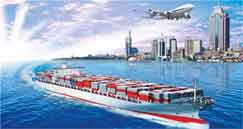The Chinese government last weekend released a six-year plan to reduce domestic logistics costs to make its economy more competitive. The move was part of a broader set of initiatives to jump start the overall economy, which has seen growth slow dramatically in the past few years.
China estimates its logistics costs as representing about 18% of its GDP currently. That’s much more than double the 7.86% percent of GDP in the US, and even substantially more than developing country rivals such as India.
Supply Chain Digest Says... |
 |
| The government is also encouraging investment in cold chain logistics infrastructure and "significant growth" in the use of outsourced logistics services. |
 |
What do you say? |
| Click here to send us your comments |
 |
| Click here to see reader feedback |
|
|
As part of the new plan, China has set a goal of reducing that ratio to 16% of GDP by 2020.
In the recently released Logistics Competitiveness Index (LCI) from the World Bank, China’s logistics competence was ranked at number 27, up one spot from 28 in the 2014 LCI. That compares with top ranked Germany at number 1 and the US at number 10, in the bi-annual ranking of 160 nations. (See What Countries are Tops in Logistics?)
Interestingly, the partially autonomous Chinese city-state of Hong Kong was in ninth place in the LCI; India was at 35, despite having lower logistics costs as a percent of GDP than China.
Another goal of the initiative is to reduce the proportion of logistics costs to the total value of goods carried by the sector by 0.5 percentage point, from the current 4.9% to 4.4% in the next three years, according to the Ministry of Transport.
"The traditional [Chinese] logistics model is no longer sustainable," the Ministry said.
How does China hope to accomplish all this?
The government is urging cooperation across different regions and between modes of transport, including the cutting of red tape and toll fees, vertical integration of transport and warehousing service providers, and better synergies among seaports, airports, railway lines and expressways. It is encouraging mergers among logistics service providers as well.
This is all crucial as much of Chinese manufacturing activity has moved further inland, away from the East Coast, in search of lower labor costs, but raising logistics costs to move the goods back to the East for consumption or export.
By reducing the ratio of logistics costs to the GDP by 1 percentage point, China can help industrial businesses save more than 900 billion yuan, or $135 billion.
The government is also encouraging investment in cold chain logistics infrastructure and "significant growth" in the use of outsourced logistics services.
Separately, the government gave approval to a prodigious infrastructure plan at Tianjin Port, where waters open to foreign cargo ships will more than triple to 1,590 square kilometers. Seventy-one more berths would be installed in the vast area, with the quay length doubled to 148 kilometers. Tianjin Port is the world's biggest artificial deepwater port and the world's fourth-largest port by tonnage throughput.
(See More Below)
|
CATEGORY SPONSOR: SOFTEON |
|
|
| |
|
|
 In addition to the strategies to streamline logistics, the Chinese government also announced other steps to boost its overall economy. Those include: In addition to the strategies to streamline logistics, the Chinese government also announced other steps to boost its overall economy. Those include:
• The value-added tax will continue to be promoted nationwide to replace business tax, which is expected to save enterprises more than 500 billion yuan (about $75 billion) each year.
• To lower funding costs, China will maintain abundant liquidity and increase credit support for small firms, agriculture and other money-starved sectors.
• Businesses with good credit will be encouraged to issue overseas bonds, and the Chinese currency, the yuan, will be promoted in cross-border transactions to cut costs.
• China will further reduce the burden on businesses by cutting their payments to social security funds. The required contribution rates for pension insurance, unemployment insurance and housing provident funds will be lowered.
• The government will relax price controls on the energy sector, reduce industrial electricity prices and lower land use prices.
Will it all work? That remains to be seen, and official economic data out of China is viewed as suspect by many, with some saying growth was as low as 3-4% in 2015, far less than the official number of about 7%.
That said, Moody's Investors Service recently raised its forecasts for China's economic growth for the mainland to 6.6% for 2016 from 6.3% previously and to 6.3% in 2017, up from 6.1%, as a result of a variety of stimulus actions.
Will China be successful in lowering its logistics costs? Why or why not? What do you think needs done? Let us know your thoughts at the Feedback section below.
Your Comments/Feedback
|